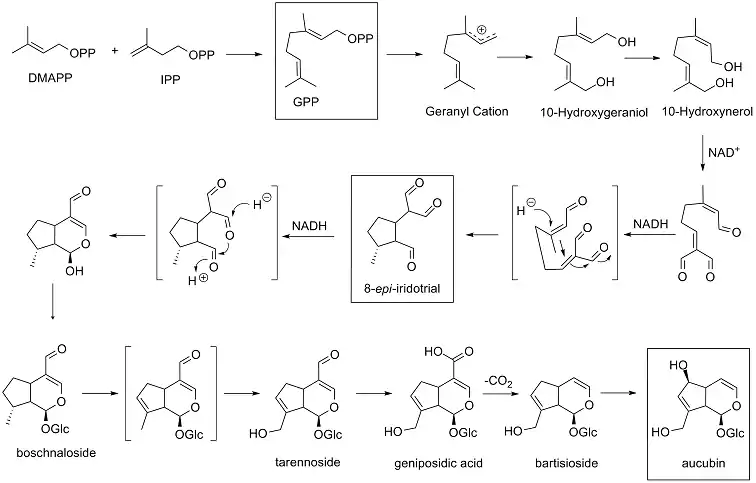Aucubine
L'aucubine est un hétéroside iridoïde présent dans certains végétaux, et ayant un usage médicinal en phytothérapie.
| Aucubine | |

| |
| Structure de l'aucubine | |
| Identification | |
|---|---|
| DCI | 91458 |
| Nom UICPA | (2S,3R,4S,5S,6R)-2-[-(1S,4aR,5S,7aS-5-hydroxy-7-(hydroxyméthyl-1,4a,5,7a-tétrahydrocyclopenta-[c]-pyran-1-yl]-oxy]-6-(hydroxyméthyl)-oxane-3,4,5-triol |
| No CAS | |
| No ECHA | 100.006.856 |
| No CE | 207-540-8 |
| PubChem | |
| SMILES | |
| InChI | |
| Apparence | solide |
| Propriétés chimiques | |
| Formule | C15H22O9 [Isomères] |
| Masse molaire[1] | 346,329 8 ± 0,016 2 g/mol C 52,02 %, H 6,4 %, O 41,58 %, |
| Propriétés physiques | |
| T° fusion | 175 à 178 °C [2] |
| Solubilité | partiellement soluble dans H2O |
| Précautions | |
| Directive 67/548/EEC[3] | |
 Xn |
|
| Unités du SI et CNTP, sauf indication contraire. | |
Elle est naturellement synthétisée par des plantes tels le Ginkgo biloba, le grand plantain (Plantago major), la scrofulaire[4] ou encore le buddleia de David (Buddleja davidii), et l'aucuba d'où elle tire son nom.
Usage
On utilise plusieurs plantes qui contiennent de l'aucubine dans la médecine traditionnelle chinoise. Parmi celles-ci, citons Aucuba japonica, Eucommia ulmoides et Plantago asiatica[5].
Effets
L'aucubine s'est avérée offrir une protection contre les dommages qu'induisent le tétrachlorométhane (CCl4) et l'α-amanitine au foie de souris et rats auxquels on a administré 80 mg·kg-1 par injection intrapéritonéale[6].
Cette substance a également des effets anti-inflammatoire[7] - [8] et anti-bactérien[9].
Biosynthèse

Notes et références
- Masse molaire calculée d’après « Atomic weights of the elements 2007 », sur www.chem.qmul.ac.uk.
- Roth, Carl, Sicherheitsdatenblatt: Aucubin, [En ligne], http://www.carl-roth.de/jsp/de-de/sdpdf/9149.PDF, page consultée le 12 mars 2011
- (de) www.carl-roth.de – Sicherheitsdatenblatt « Aucubin > 97 % »
- Faivre, C. (2007), Scrofularia nodosa. Phytothérapie, 5(3), 154-158. (résumé)
- Suh, N., Shim, C., Lee, M., Kim, S., Chung, I., Pharmacokinetic Study of an Iridoid Glucoside: Aucubine, Pharmaceutical Research, 8 (8), 1059-1063
- Yang, K., Kwon, S., Choe, H., Yun, H., Chang, I., Protective Effet of Aucuba japonica Against Carbontetrachloride Induced Liver Damage in Rat, Drug Chem. Toxicol., 1983, 6 (5), 429-441
- Bermejo Benito P, Diaz Lanza AM, et al., Effects of some iridoids from plant origin on arachidonic acid metabolism in cellular systems, Planta Med., 2000, 66(4), 135-146
- Schidgall, J., Schnetz, E., Hensel, A., Evidence for bioadhesion assay on buccal membranes, Planta Med., 2000, 66 (1), 48-53
- Blumenthal, M., Goldberg, A., Brinckmann, J.(Ed), Expanded Commission E Monographs: Plantain, American Botanical Council, en collaboration avec Integrative Medicine Communications, États-Unis, 2000